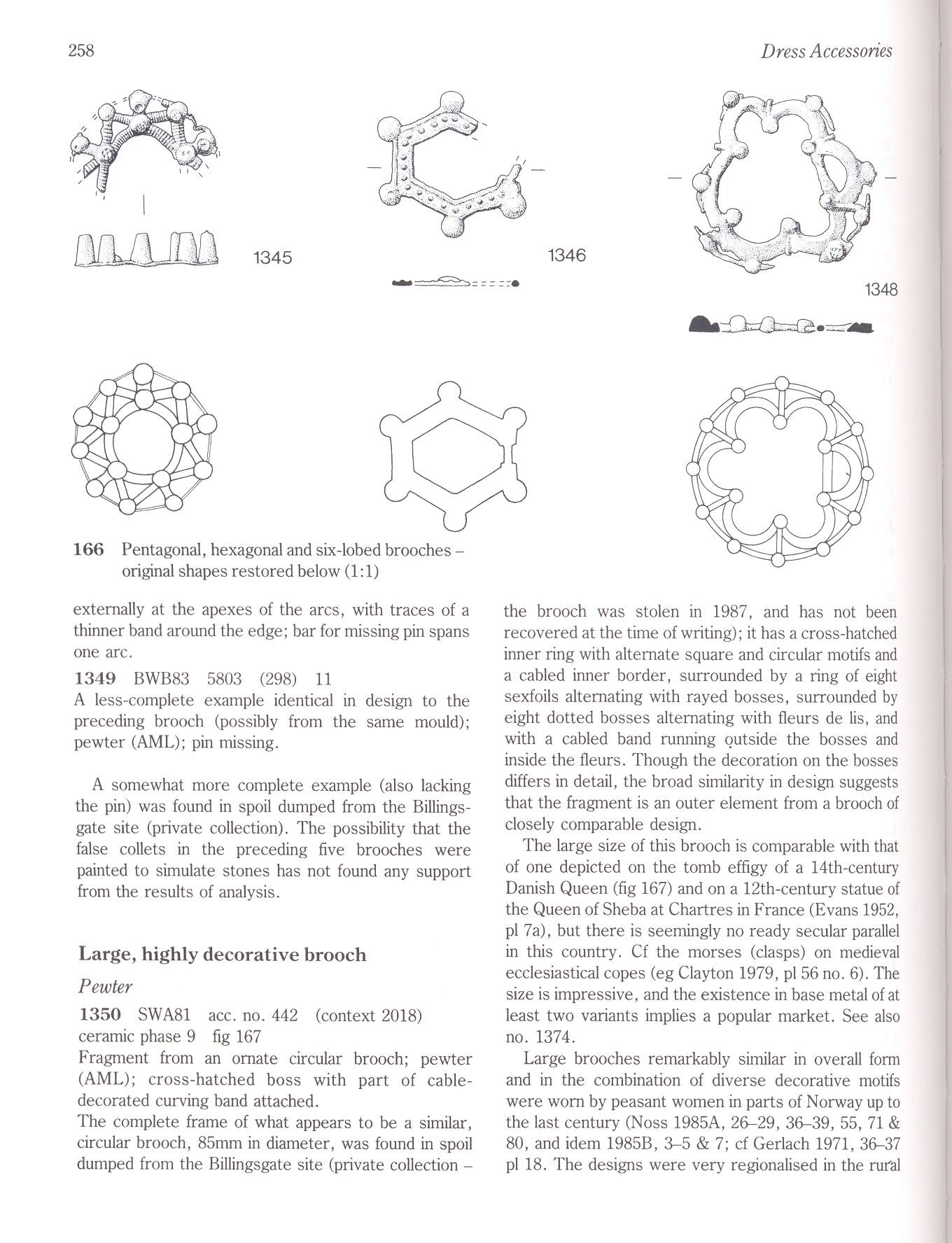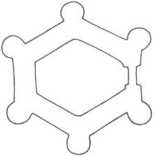286 (34)

258
Dress Accessońes



166 Pentagonal, hexagonal and six-lobed brooches -odginał shapes restored below (1:1)

extemally at the apexes of the arcs, with traces of a thinner band around the edge; bar for missing pin spans one arc.
1349 BWB83 5803 (298) 11 A łess-complete example identical in design to the preceding brooch (possibly from the same mould); pewter (AML); pin missing.
A somewhat morę complete example (also lacking the pin) was found in spoił dumped from the Billings-gate site (private collection). The possibility that the false collets in the preceding five brooches were painted to simulate Stones has not found any support from the results of analysis.
Large, highly decorative brooch
Pewter
1350 SWA81 acc. no. 442 (context 2018) ceramic phase 9 fig 167
Fragment from an omate circular brooch; pewter (AML); cross-hatched boss with part of cable-decorated curving band attached.
The complete frame of what appears to be a similar, circular brooch, 85mm in diameter, was found in spoił dumped from the Billingsgate site (private collection -the brooch was stolen in 1987, and has not been recovered at the time of writing); it has a cross-hatched inner ring with altemate square and circular motifs and a cabled inner border, surrounded by a ring of eight sexfoils altemating with rayed bosses, surrounded by eight dotted bosses altemating with fleurs de lis, and with a cabled band running outside the bosses and inside the fleurs. Though the decoration on the bosses differs in de taił, the broad similarity in design suggests that the fragment is an outer element from a brooch of closely comparable design.
The large size of this brooch is comparable with that of one depicted on the tomb effigy of a 14th-century Danish Queen (fig 167) and on a 12th-century statuę of the Queen of Sheba at Chartres in France (Evans 1952, pl 7a), but there is seemingly no ready secular parallel in this country. Cf the morses (clasps) on medieval ecclesiastical copes (eg Clayton 1979, pl 56 no. 6). The size is impressive, and the existence in base metal of at least two variants implies a popular market. See also no. 1374.
Large brooches remarkably similar in overall form and in the combination of diverse decorative motifs were wom by peasant women in parts of Norway up to the last century (Noss 1985A, 26-29, 36-39, 55, 71 & 80, and idem 1985B, 3-5 & 7; cf Gerlach 1971, 36-37 pl 18. The designs were very regionalised in the rufal
Wyszukiwarka
Podobne podstrony:
320 (34) 292 Dress Accessońes Psalter shows a lady’s long hair being prepared for pinning up in this
339 (31) 312 Dress Accessońes 207 Bonę beads - top left; waste - top right; waste panels - below(1:1
314 (34) 286 Dress Accessońes one side ending in chapes, wom by a woman. Pourpoints and aketons (bot
416 (14) 389Metallurgical Analysis of the Dress Accessories Lead Lead Fig 258 Ali copper alloys. Eac
274 (42) Dress Accessońes 246 1078 805 1095 (A) mounts with fields of dots (1:1) (
276 (40) 248 Dress Accessońes because no indication has been recognized on them of the wearer’s adhe
278 (40) 250 Dress Accessories 1314 1311 SWA81 2186 (2055) 9 fig 160 Corroded
284 (41) 256 Dress Accessońes Hooked annular brooch Copper alloy 1338 SWA81 acc. no. 1493 (context
292 (37) 264 Dress Accessories 1365 171 Yiolet brooches (drawings 1:1, photograph 2:1) (?)flower bud
296 (37) 268 Dress Accessońes Brooches with circular frames Leaf 1374 BC72 2037 (83) 11 fig 174 Poss
298 (39) 270 Dress Accessories Table 5 Brooches - metals used 1 1 Copper i i 2 I I I -1-1—[— 1 1 1
302 (41) 274 Dress Accessońes buttons of the former kind, found in Lund in Sweden). Composite sheeti
304 (37) 276 Dress Accessońes slightly damaged (an impressed dot here may not be an original feature
306 (35) 180 180 278 Dress Accessońes Cloth buttons and corresponding holes on a sleeve from a depos
308 (39) 280 Dress Accessońes late 13th century onwards. The alloys used in buttons prior to that co
310 (36) 282 182 Lace chapes: terminology Dress Accessories O edge to edge seam overlapping seam end
312 (36) 284 Dress Accessories O /v- <& © - O 1428 1406 0 184 Lace chapes (1:1) 1426
318 (36) 290 Dress Accessories one has a tiny spoon at the opposite end from the nib, though MoL acc
322 (32) 294 Dress Accessories Unthrown silk was bound round the wire in at least 11 examples (nos.
więcej podobnych podstron